Epiphyllums, also known as orchid cacti, are large, succulent plants with long, flat, leafless stems that produce breathtaking blooms.
There are many different species that go by the name “epiphyllum,” as well as thousands of colorful hybrids to tempt the houseplant lover or orchid cactus collector.
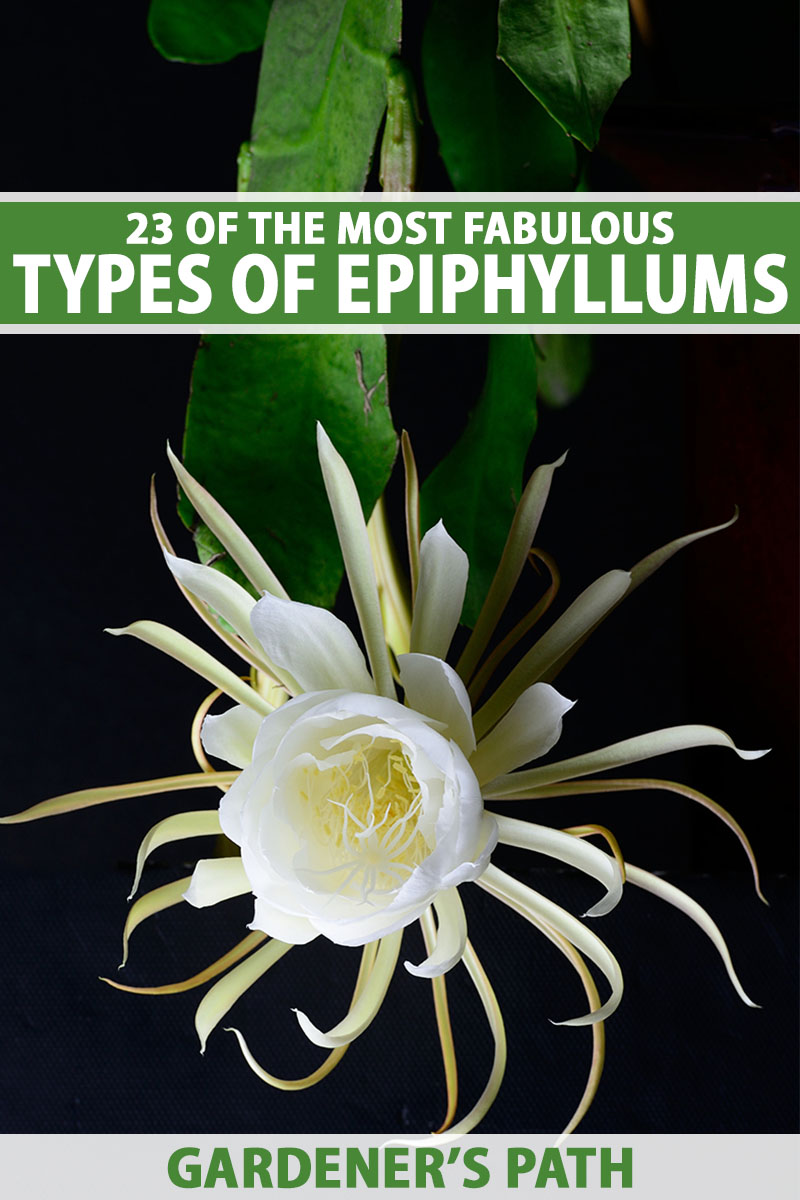
We link to vendors to help you find relevant products. If you buy from one of our links, we may earn a commission.
I’ve cultivated a list of 23 different selections to give you a feel for these fascinating leaf cacti and introduce you to some you might want to consider growing yourself!
Here’s a peek at our list:
23 of the Best Epiphyllums for Home Gardeners
We’re going to interpret the term “epiphyllum” broadly for the purposes of this roundup, including three different types of plants: members of the Epiphyllum genus, some species that were formerly classified in the genus, and epiphyllum hybrids.
I’ll let you know what type of epiphyllum we’re dealing with for each selection. but first, a little more on these distinctions so that you can understand what to expect from each plant:
Epiphyllum is a genus that currently includes nine or 10 different species, depending on who you ask.
However, several species that were once included within this genus have since been reclassified and placed in other genera such as Selenicereus or Disocactus. (I’ll forgive you – and even applaud you – if you want to join me in secretly thinking of that last one as “disco cactus.”)
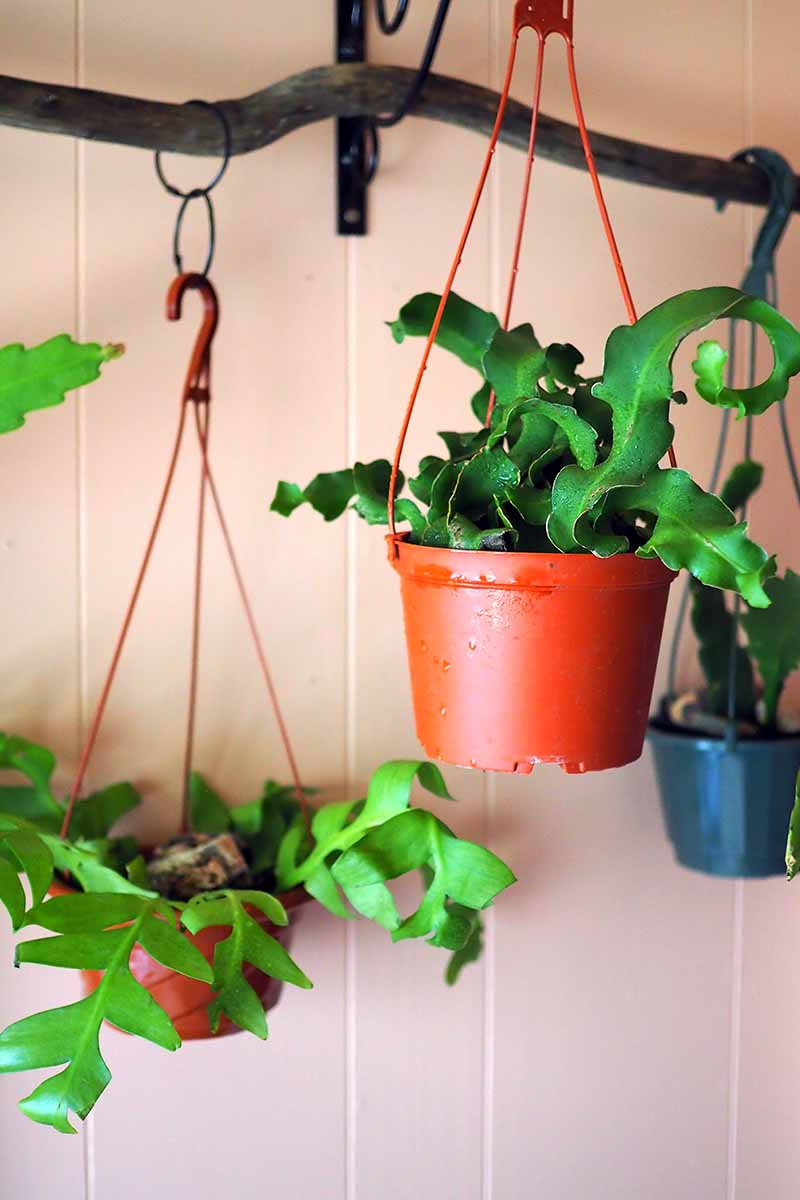
Despite their new scientific names, these members of the Cactaceae family and the Hylocereeae tribe are still widely referred to as epiphyllums.
Finally, hybrid epiphyllum cultivars are bred for big, showy, colorful blooms. Some of these hybrids have Epiphyllum ancestry, but others may be crosses of Selenicereus or Disocactus species, or species of different genera.
Collectors and fans of these cacti call them “epiphyllums” or “epis,” for short, nonetheless.
What we’re not going to include in our selection today is plants that were formerly classified in a totally different Epiphyllum genus.
The short story on this other use of this botanical name is this: two botanists had the same great idea for a name, but they weren’t talking about the same plants – or to each other – when they separately came up with that name.
Those plants are members of the Schlumbergera genus, whose most famous representative you’ll recognize by the common name “Christmas cactus.”
If you’d like to learn more about growing and caring for Christmas cacti, read our complete guide.
Let’s also cover a little flower anatomy before we dig into our epiphyllum selections so you can fully appreciate the big blooms on these plants – the lesson will be short, I promise!
Epiphyllums tend to produce exceptionally large blooms, and that means all the distinct parts of the flower are much more readily visible than what you might see in other types of blossoms.

In the photo above, which depicts an Epiphyllum bloom with narrow white petals, you can see a yellow stigma and pink style surrounded by delicate white stamens.
Now you’ll know what I’m talking about when I use those terms moving forward.
That’s it! Lesson over.
For each of our selections, I’ll let you know what to expect in terms of the color, shape, and arrangement of the flower petals, as well as the color of stigma, style, and stamens.
You’ll also learn about foliage and growth habit, though I’ll go ahead and let you know that in general, epiphyllum hybrids tend to be compact in size, while the mature sizes of species plants varies from one to the next, with some growing prodigiously.
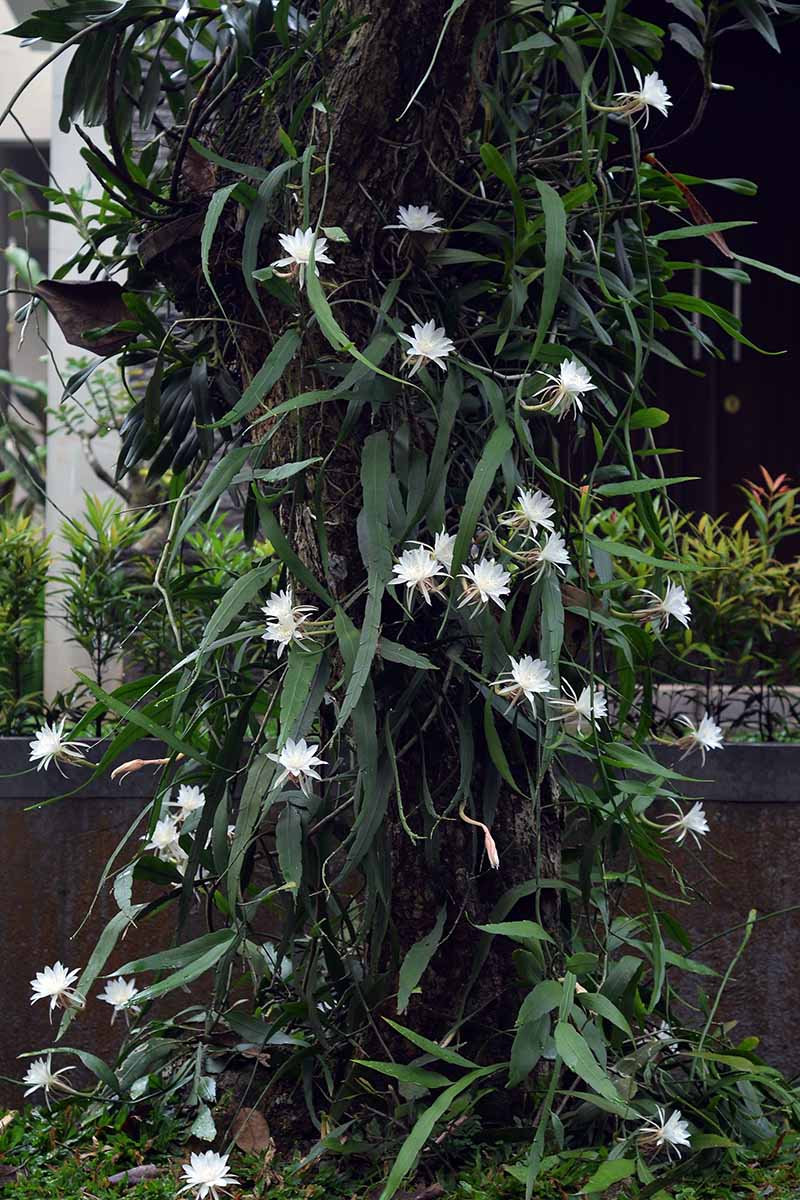
And just a reminder, we’re not going to cover care needs in this article, so if you’d like guidance for staking, repotting, fertilizing, and encouraging blooms in these plants, as well as tips on general needs like water and sun exposure, be sure to check out our complete guide to growing epiphyllums.
And now begins our excursion into the realm of the orchid cacti!
1. Ackermannii
Our first selection is commonly known as “red orchid cactus.”
Although this species used to be classified as a member of the Epiphyllum genus, E. ackermannii has since been reclassified to the closely related Disocactus genus, and is now known botanically as D. ackermannii.
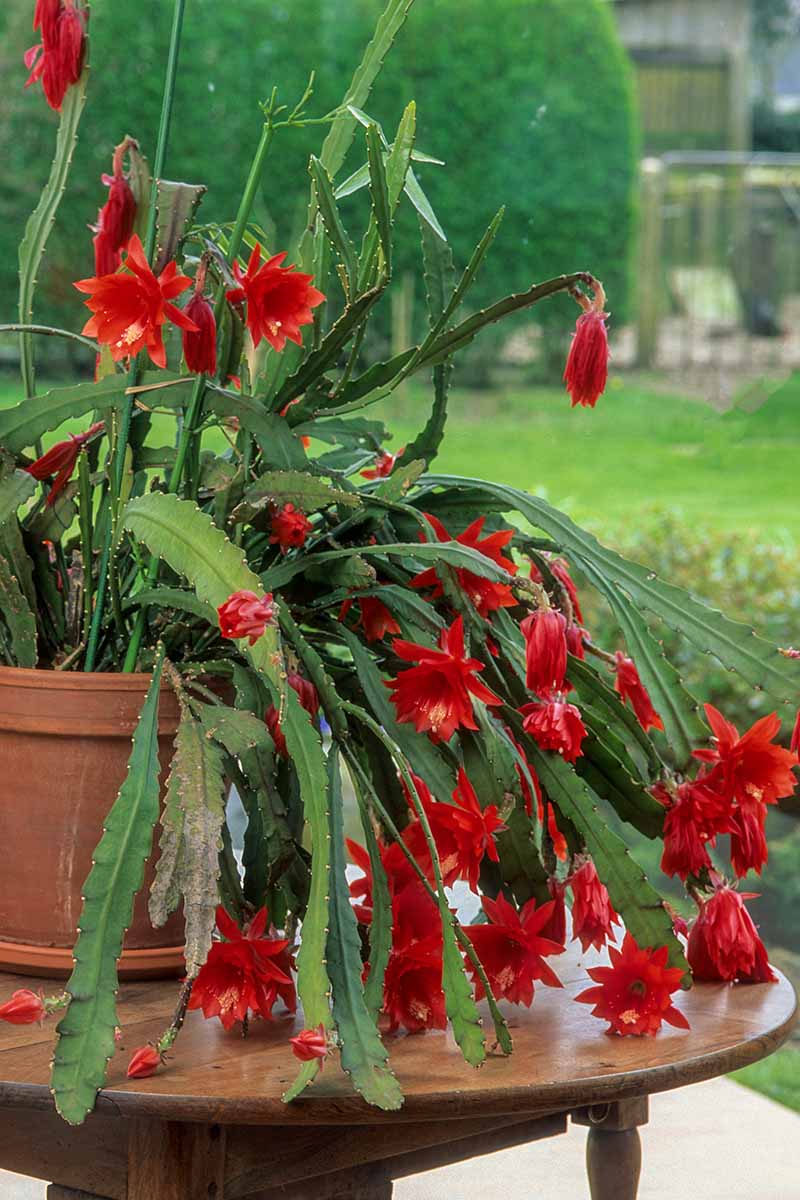
Red orchid cactus blooms in the springtime, bearing scarlet red, funnel-shaped flowers that reach five inches across or more. These are delicately scented, and last for a few days before fading.
The stems of red orchid cactus reach seven inches to three feet long, and have prominent veins and undulating to toothed margins. These stems display upright growth before trailing down.
In 2012, this species received the Royal Horticultural Society’s Award of Garden Merit.
D. Ackermannii Red Orchid Cactus in 6” Pot
Interested in purchasing a specimen of your own? You’ll find a live, red-flowered D. ackermannii orchid cactus in a six-inch pot from Bubble Blooms via Walmart.
2. American Sweetheart
‘American Sweetheart’ is an epiphyllum hybrid with gorgeous pink and golden-pink blooms.
Flowers are extra-large, reaching nine inches wide or more, and have a cup and saucer form, with pink inner petals and golden-pink outer petals. The stigma and stamens of this cultivar are cream colored.
‘American Sweetheart’ has flat stems and grows well in a hanging basket.
3. Anguliger
Commonly called “zigzag cactus” or “fishbone cactus,” Disocactus anguliger is another species that has been ousted from the Epiphyllum genus.
Also previously classified as Cereus mexicanus, which is considered a synonym, fans of forest cacti will frequently see this species referred to as E. anguliger.
Its flat, wide stems are deeply lobed, making one think of the skeleton of a fish – or of rickrack ribbon, which gives rise to another common name, “ric rac cactus.”
This species bears medium-sized flowers that measure five to seven inches across.
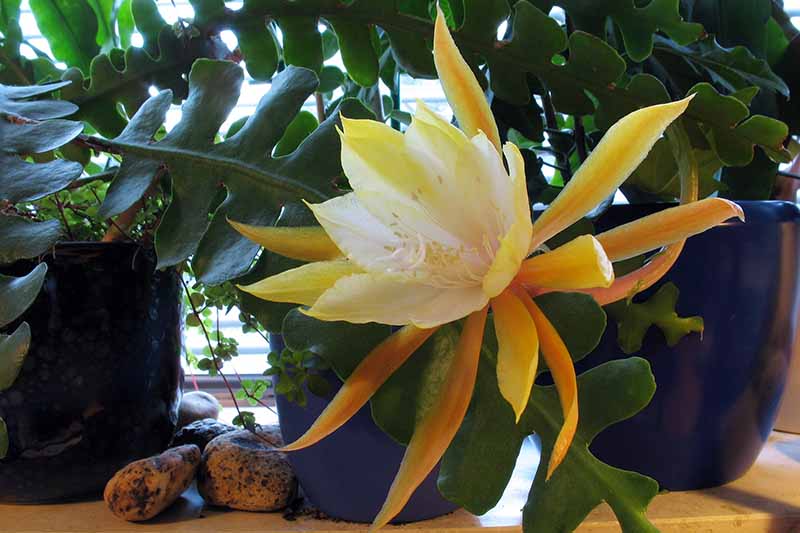
Inner petals are white to cream colored, broad and overlapping, surrounded by golden to golden brown, narrow outer petals. Stigma, stamens, and style are all white.
These flowers bloom at night and are short lived, remaining open for 12 to 24 hours.
D. anguliger grows well in a hanging basket and has prolific foliage, which can grow several feet long.

D. Anguliger Set of 3 in 4” Pots
To add this species to your collection, you’ll find a set of three D. anguliger fishbone plants in four-inch pots from California Tropicals via Amazon.
Learn more about growing and caring for fishbone cactus in our article. (coming soon!)
4. Anthonyanus
Our next selection is commonly called “fishbone cactus.”
Are you getting a feeling of déjà vu?
Glad to know you’re paying attention – yes, that common name should sound very familiar! I suppose the world is big enough for two fishbone cacti, isn’t it?
Along with bearing a remarkably close resemblance to the previous selection, this species (Selenicereus anthonyanus) shares additional common names with that other fishbone cactus – “ric rac cactus” as well as “zigzag cactus.”
While S. anthonyanus was never classified botanically as an Epiphyllum, it is often confused with its lookalike and is frequently referred to as an epiphyllum.
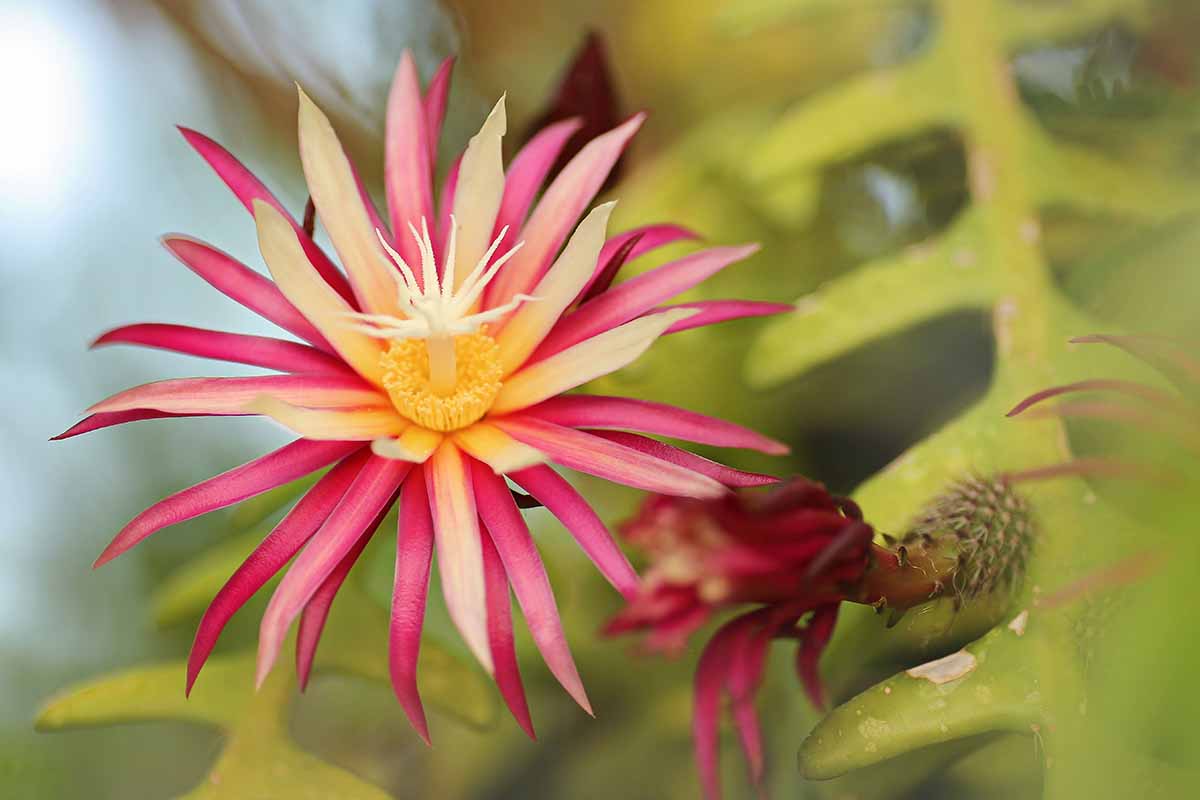
S. anthonyanus has long, flat stems that are deeply lobed, with a fishbone shape. Compared to D. anguliger, the lobes are sharper and less rounded – but only on more mature stems!
Younger specimens of these two species can be extremely hard to distinguish from each other based on their foliage.
The blooms of S. anthonyanus are medium-sized, reaching five to seven inches across, and are short lived, opening for one night a year.
This species’ fragrant flowers have narrow petals, with cream and yellow inner petals and outer petals that are reddish purple. The yellow stamens on these flowers are shorter than those of our other selections, and the bloom’s style and stigma are white.
This species will thrive with more direct sun than the other epiphyllums described here, and is considered a shy bloomer.
Selenicereus Anthonyanus in 6” Pot
You can find an S. anthonyanus fishbone cactus in a six-inch pot from the House Plant Shop via Walmart.
5. Apache Magic
‘Apache Magic’ is an attractive, orange- and pink-flowered epiphyllum hybrid.
Flowers have a cup and saucer form and are large, with broad, overlapping petals.
Petals are orange with hot pink margins, surrounding cascading stamens, a creamy pink style, and a white stigma.
The foliage of ‘Apache Magic’ has both flat and triangular growth.
6. Chrysocardium
Commonly known as “fern leaf cactus” or “shark tooth cactus,” this species suffers from a bit of an identity crisis – or at least, botanists have bestowed it with one.
According to the Royal Horticultural Society, the official classification of this species is unresolved.
Perhaps it’s an Epiphyllum species. Or perhaps it’s more closely related to S. anthonyanus, the purple-flowered fishbone cactus we encountered above.
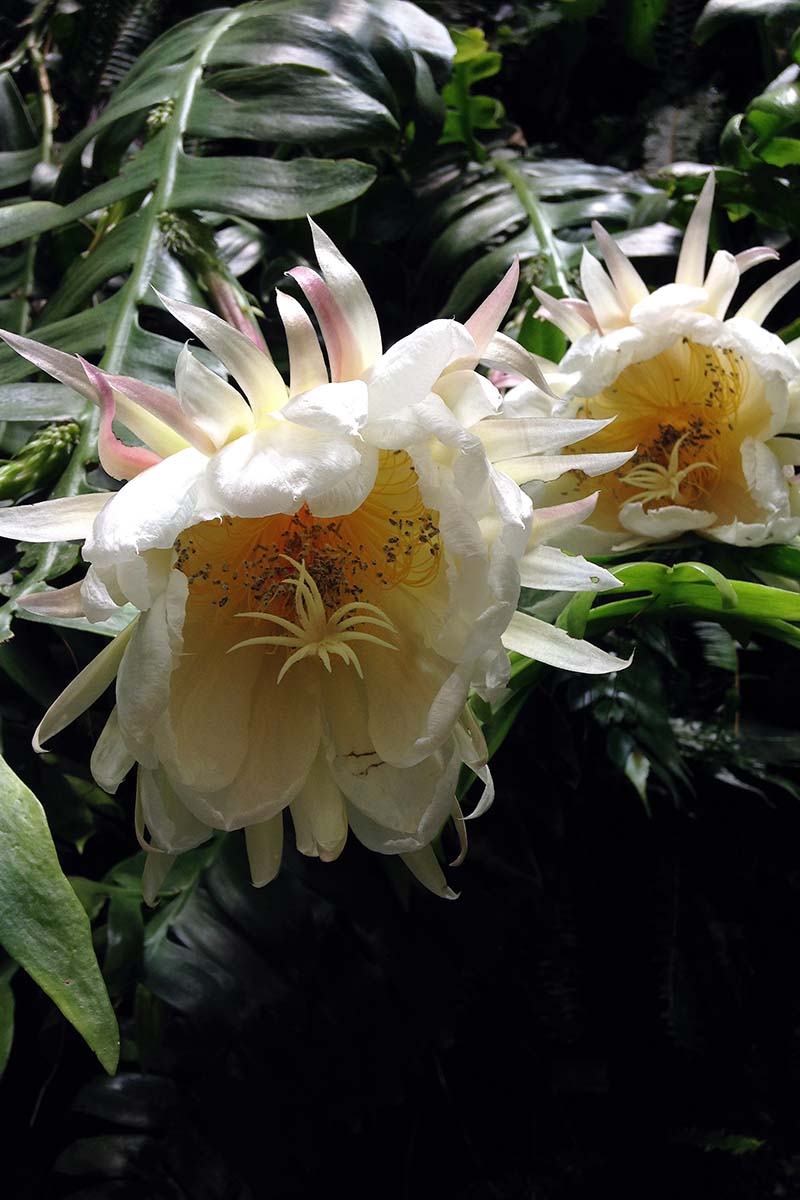
Call it Selenicereus chrysocardium or E. chrysocardium; either way, this cactus is commonly referred to as an epiphyllum.
This species has long, flat stems that are deeply lobed and look like the foliage of ferns.
Its flowers are eight inches wide, with broad, overlapping, white inner petals and narrow white and pink outer petals. The white to pale yellow stigma is surrounded by golden stamens, which give this plant another common name, “golden heart epiphyllum.”
Plants have a trailing growth habit, with stems reaching up to six feet long. This species is well suited for hanging baskets, and is considered a shy bloomer.
You’ll find an S. chrysocardium shark tooth cactus available for purchase in a six-inch pot from California Tropicals via Amazon.
7. Clown
‘Clown’ is a colorful epiphyllum hybrid with tricolored blooms.
Flowers have a cup and saucer form and are large, reaching seven to nine inches wide.
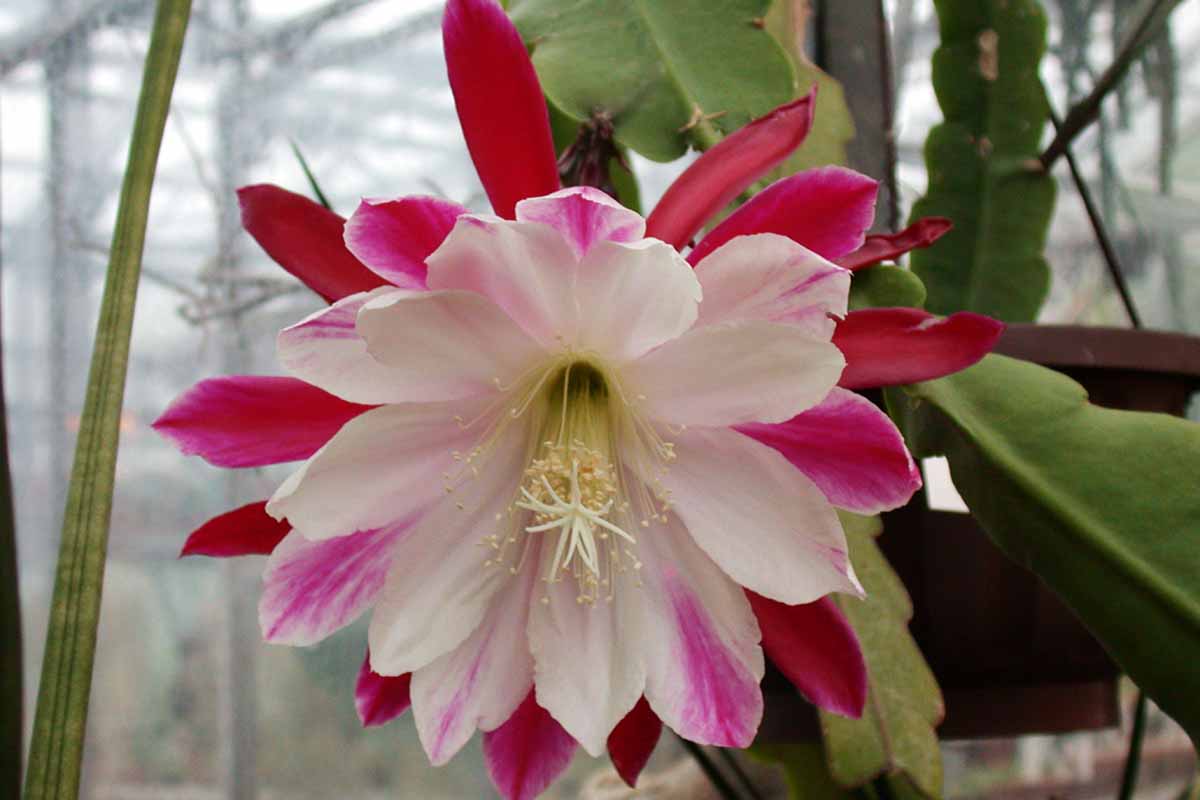
Outer petals are narrow and red, forming spokes around broad, overlapping inner petals that are white with raspberry veining and midstripes. The stigma, style, and stamens of ‘Clown’ are white.
This hybrid is prone to spotting, a primarily cosmetic issue that affects epi foliage, and especially certain hybrids.
8. Connie Mayer
‘Connie Mayer’ is an epiphyllum hybrid whose extra-large, purple blooms are short lived but make a long-lasting impact.
The purple petals of its flowers are narrow but abundant, resembling the purple streaks of fireworks as they explode. The inner petals of ‘Connie Mayer’ are magenta to purple, surrounded by slightly darker outer petals.
The style is purple, stigma is white to yellow, and stamens are yellow.
The flowers of this night-blooming epiphyllum last one night only, but they are huge, ranging in size from nine to 14 inches wide.
Stems are three-sided on plants that grow to be very large.
‘Connie Mayer’ is a cross of Selenicereus undatus and S. stenopterus.
9. Crenatus
Known as the “crenate orchid cactus,” this former member of the Epiphyllum genus is now classified as Disocactus crenatus.
Bearing delicately scented white flowers, E. crenatum and Cereus crenatus are considered synonyms for this species.
Blooms are funnel shaped with broad white petals, and can reach eight inches wide.
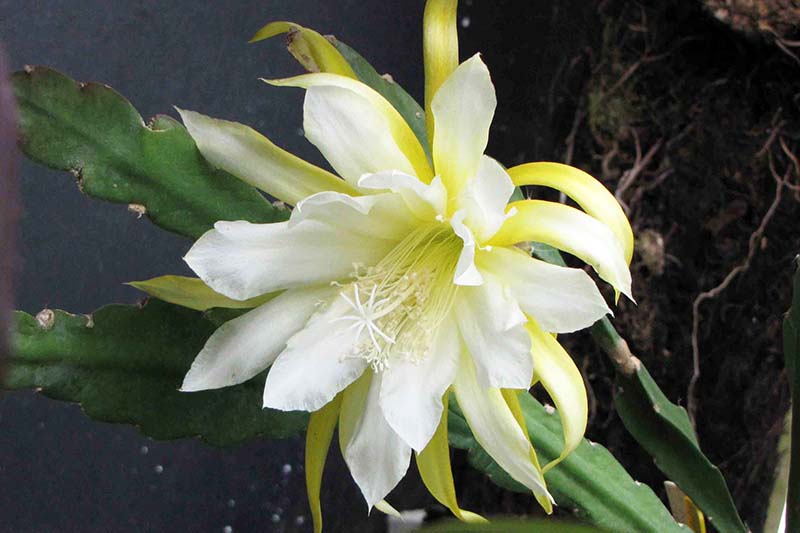
In spring or summer, D. crenatus bears day-blooming flowers, which remain open for a few days.
Foliage grows upright then weeps, growing up to 10 feet long, with flattened stems that are two inches wide.
This species has been widely used by epiphyllum hybridizers.
10. George French
‘George French’ is a cheery epiphyllum hybrid named after a world-renowned epiphyllum hybridizer.
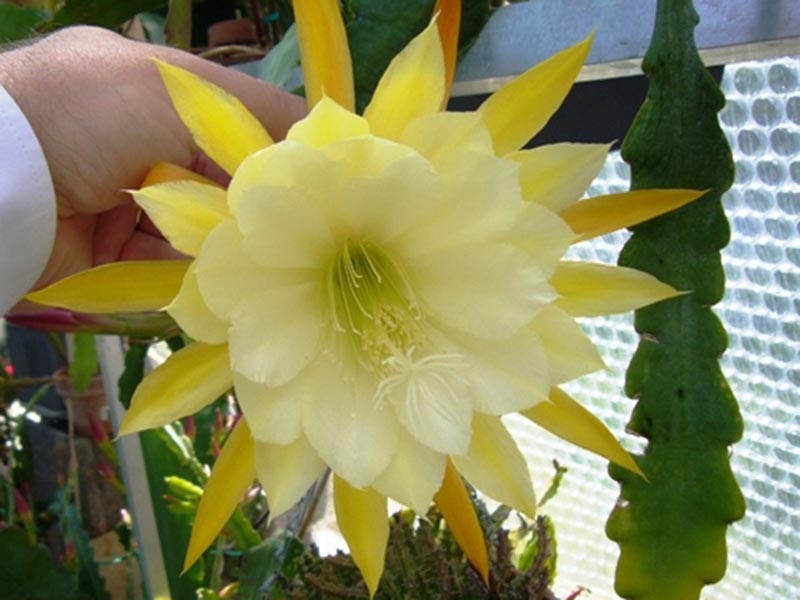
The fragrant blooms of this cultivar have pale yellow inner petals transitioning to darker yellow outer petals.
Flowers have an open shape and are medium-sized, measuring four to six inches wide.
These plants have an upright growth habit.
11. Guatemalense
Guatemalan orchid cactus is an Epiphyllum subspecies, classified as E. hookeri ssp. guatemalense, that is grown more for its unusual foliage than for its flowers.
Also known as “curly locks epiphyllum” or “curly sue,” this species has wavy stems that look like thick locks of hair, particularly in more mature specimens with long stems that twist and turn as they trail.
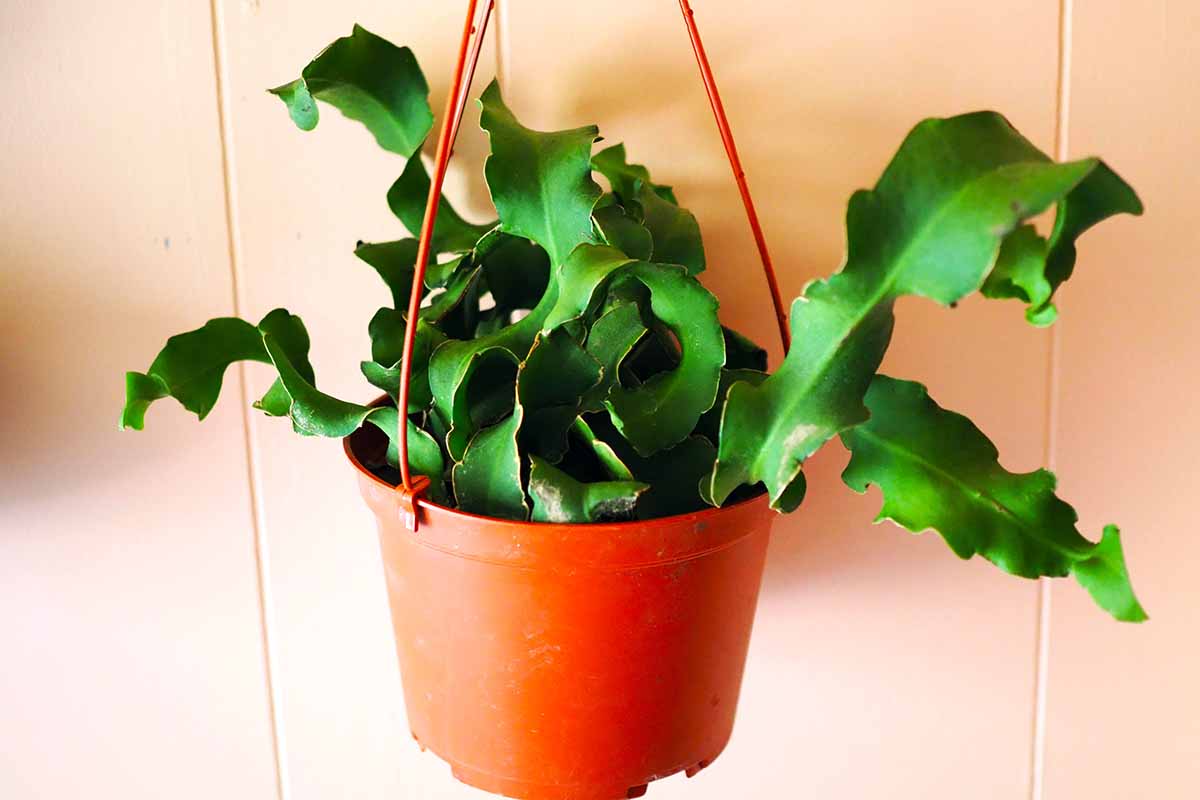
This subspecies was formerly classified as E. guatemalense, which is considered a synonym. Some sources also refer to it as E. guatemalense ‘Monstrose.’
Its wavy stems have prominent midveins, and bear blooms that are three inches wide and white, which open at night. Flowers give way to rounded, pink fruit.
Curly Locks E. Hookeri subsp. Guatemalense in 6” Pot
You’ll find a curly locks specimen in a six-inch pot available for purchase from the House Plant Shop via Walmart.
You can learn more about growing curly locks orchid cactus in our article. (coming soon!)
12. Hookeri
Known by the common name “Hooker’s orchid cactus,” E. hookeri is a species in the Epiphyllum genus.
It was formerly classified as Cereus hookeri and E. phyllanthus ssp. hookeri, which are considered synonyms.
White flowers are large, reaching seven to nine inches across, and are unscented or have a very delicate fragrance.

Blooms are wheel shaped, with narrow, spoke-like petals, surrounding white stamens and a bright pink style with a yellow stigma.
Hooker’s orchid cactus blooms for one night a year in spring, summer, or fall, and produces bright pink fruits.
The wavy-margined stems of this species can reach six to 10 feet long – or sometimes more – and can be both flat and triangle shaped.

Hooker’s Orchid Cactus Cuttings
You’ll find Hooker’s orchid cactus cuttings available for purchase from Vicky’s Garden via Amazon.
13. King Midas
‘King Midas’ is an epiphyllum hybrid with dazzling golden-orange blooms.
The large flowers have a cup and saucer form, measure seven to nine inches wide, and remain on the plant for three to four days.
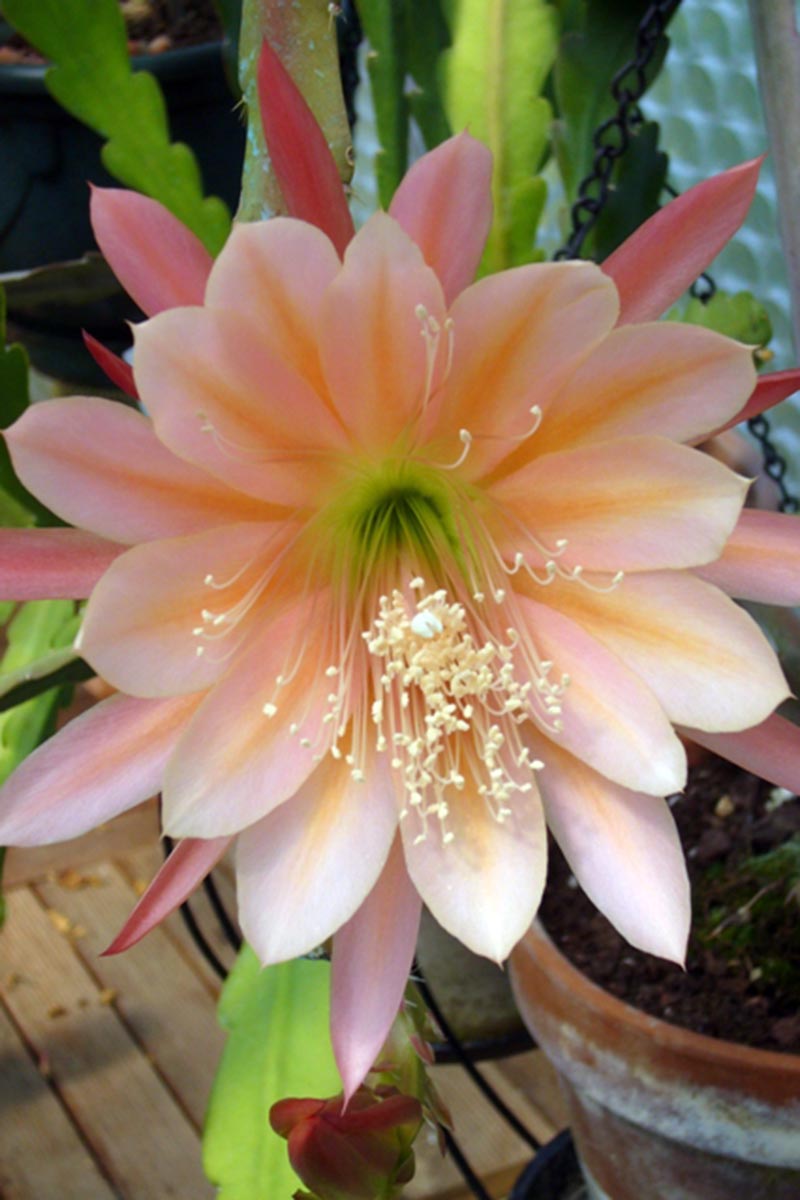
Petals are salmon to orange with a darker orange midstripe, surrounding a creamy stigma and stamens, and pink style.
Plants have an upright growth habit and are spiny.
14. Kiwi Razzle Dazzle
With blooms so full of petals, you might mistake the flowers of orchid cactus hybrid ‘Kiwi Razzle Dazzle’ for those of a dahlia.
Large flowers have multiple rows of overlapping petals. Inner petals are purple with light pink edges, and outer rows are orange with purple-pink edges.
The stigma and stamens of this epiphyllum are white.
Plants have an upright growth habit, with both flat and triangular stems.
15. Laui
E. laui is a member of the Epiphyllum genus that has funnel-shaped flowers.
Blooms have broad, overlapping, white inner petals with golden brown outer petals, blooming in spring or summer.
Flowers open in the evening and are short lived, remaining open for approximately two days.
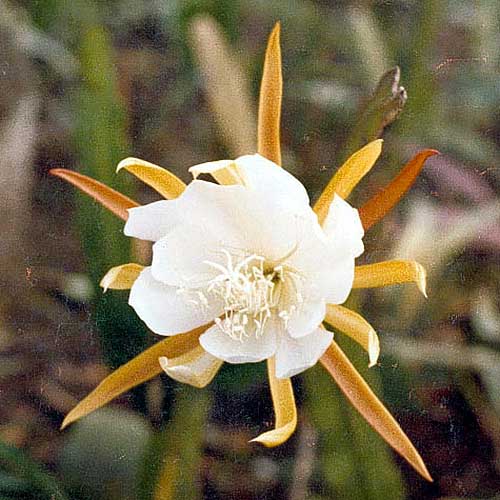
E. laui can take a very long time – sometimes many years – to flower. When it does, this species then produces fruits that are red to pink.
Plants are quite compact, reaching 12 inches tall and 20 inches wide, and can be spiny.
The stems of E. laui are glossy and tinged with red. These have prominent midribs, and scalloped or wavy margins.
16. Madras Ribbon
‘Madras Ribbon’ is an eye-catching orchid cactus hybrid with bicolored blooms.
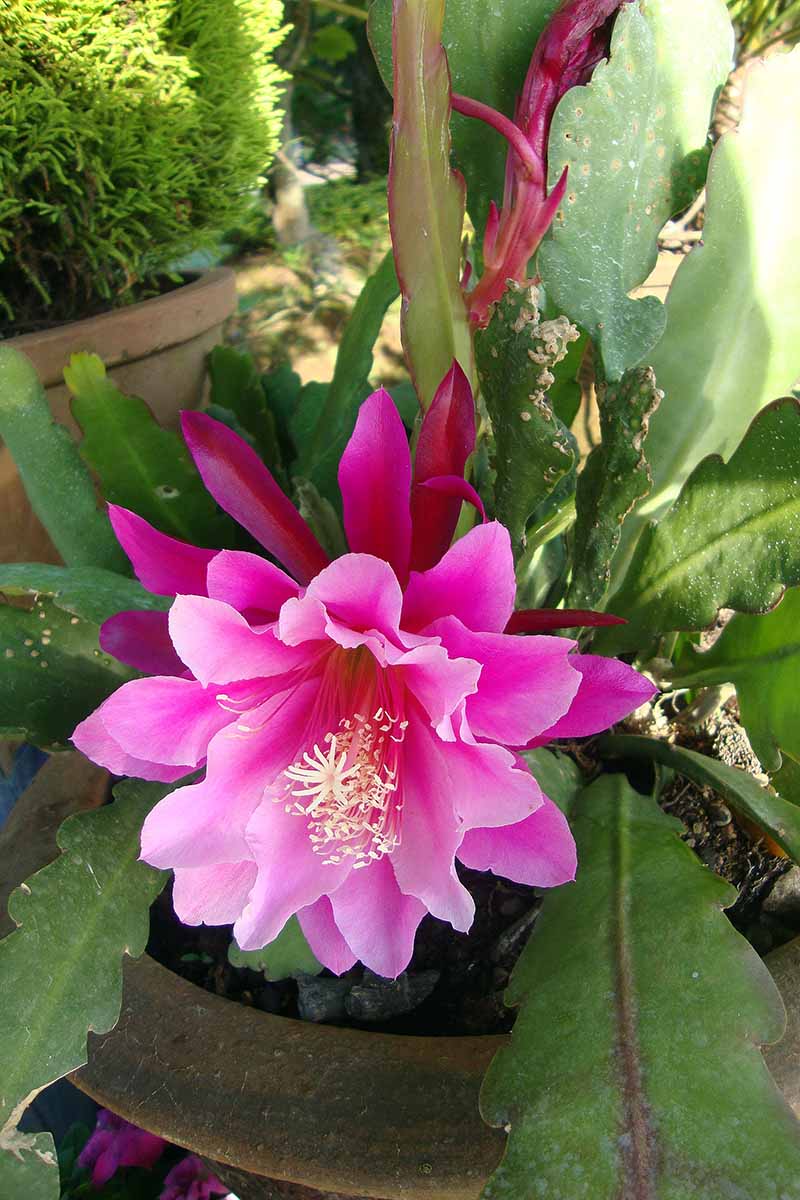
Broad, wavy inner petals are bright pink with a darker pink midstripe, while outer petals are dark pink with feathery orange midstripes.
The foliage of this orchid cactus is flat and broad, with wavy margins.
17. Oxypetalum
Queen of the night, or E. oxypetalum, is the most well-known member of the Epiphyllum genus.
E. oxypetalum blooms in spring or summer, bearing large, short-lived flowers that last only one night, fading by morning.
Inner petals are white, broad, and overlapping, while outer petals are narrow and range in color from cream to golden brown to pink.
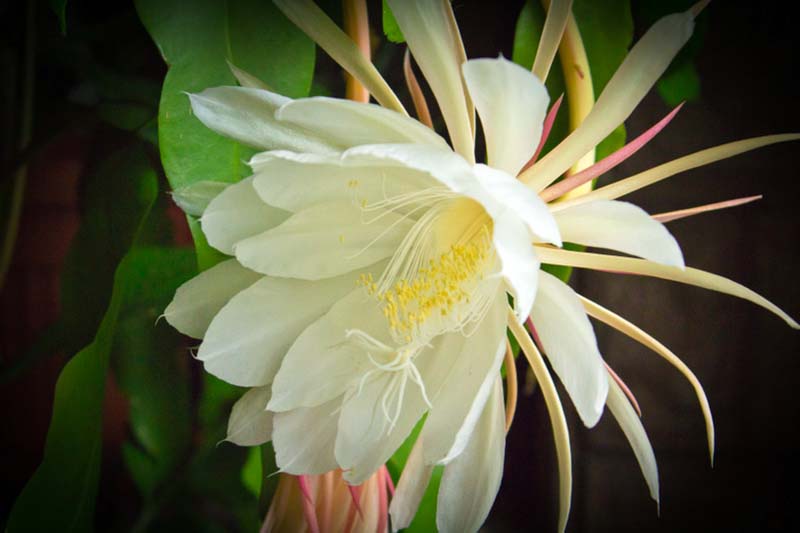
Also known as “Dutchman’s pipe,” this species is a prodigious grower, with stems that can be up to five inches wide and can grow to be over 10 feet in length. Stems grow upright before trailing down, and produce secondary branches.
Queen of the night will be perfectly content in a hanging basket, and makes an excellent houseplant. Plants will require staking for an upright display
Also known as “night-blooming cereus” and “lady of the night,” this species shares these common names with another “queen of the night” from a different genus and tribe – Cereus peruvianus, a desert species that has different care needs than our forest species.
You can learn more about this desert species in our article on C. peruvianus. (coming soon!)

E. Oxypetalum Queen of the Night Plant
Looking for an epiphyllum queen of the night specimen? You’ll find one in a grower’s pot from the Easy to Grow Store via Amazon.
For more tips on caring for E. oxypetalum – read our article on growing queen of the night. (coming soon!)
18. Pegasus
With multicolored blooms, ‘Pegasus’ is an enchanting epiphyllum hybrid.
Flowers have broad inner petals that are purple with an orangish-red midstripe and outer petals that are bronze violet.
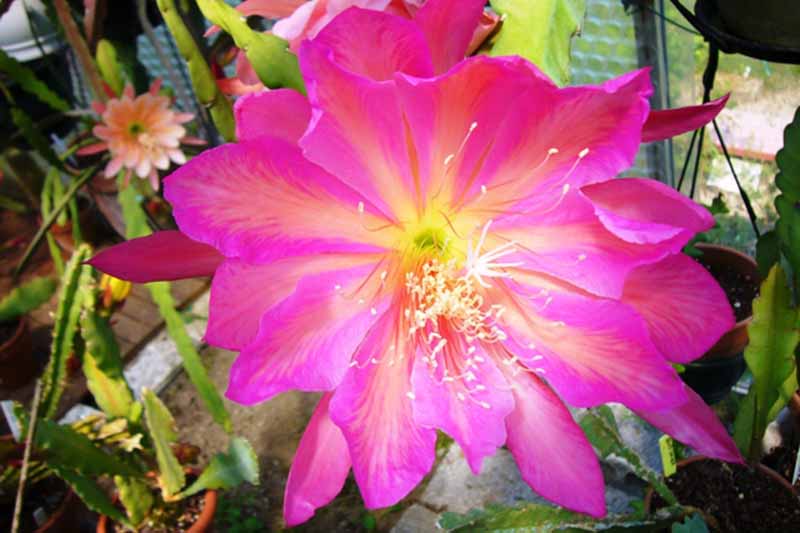
The blooms of this orchid cactus cross are extra large, measuring nine inches wide or more, and have a funnel form, opening wide around cream-colored stigma, style, and stamens. Blooms last one to two days.
The weeping growth habit of ‘Pegasus’ makes it well suited for hanging baskets.
19. Phyllanthoides
Disocactus phyllanthoides is a species plant known by the common name “German empress.”
This former member of the Epiphyllum genus was previously classified as E. phyllanthoides, as well as Nopalxochia phyllanthoides and Cereus phyllanthoides, which are now considered synonyms.
It is also known as “pond lily cactus” and “empress.”
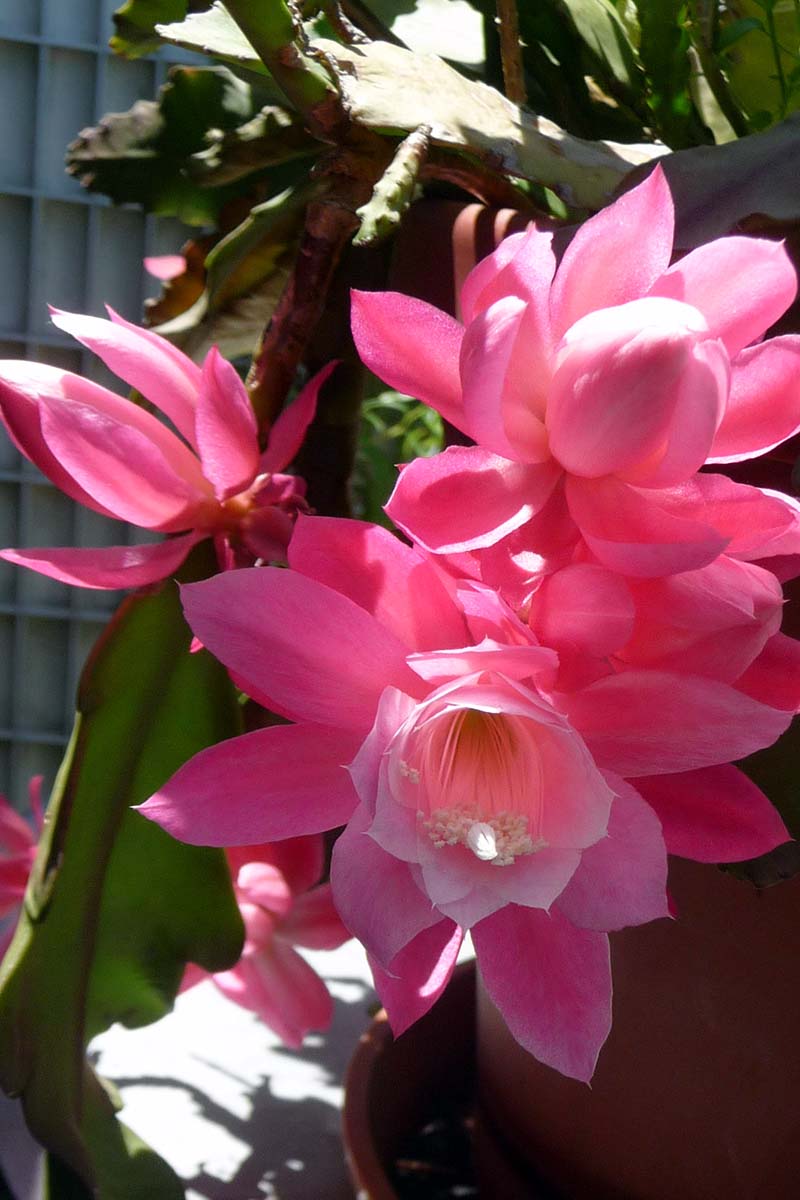
German empress bears unscented flowers that are bell shaped to funnel shaped, with mid- and outer petals that are bright pink, and paler pink inner petals.
Flowers bloom during the daytime, primarily in spring, with some specimens flowering three times a year.
This species has pendulous, flattened stems that typically grow to three feet long, sometimes more. Stems have pointed tips and serrated margins. These plants will grow beautifully in a hanging basket.
20. Phyllanthus
A member of the Epiphyllum genus, E. phyllanthus is also known as “climbing cactus.”
This species bears small, scented flowers that are white and two inches wide, opening at night.
The petals of E. phyllanthus are narrow and short. The outer petals are greenish white and inner petals are cream to white, surrounding a pink or white style, and white stigma and stamens.
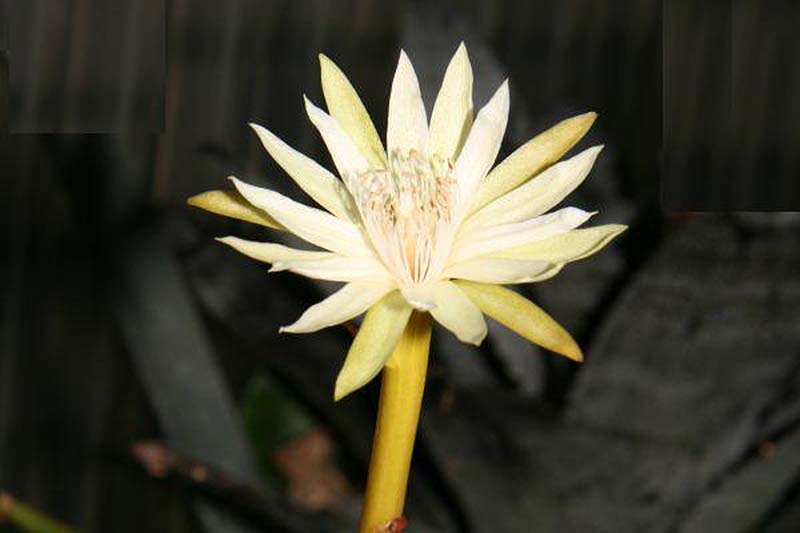
The fruits of this species are ribbed, oblong, and bright red or purple.
With a climbing habit in the wild, the branching stems of E. phyllanthus can reach up to 10 feet long, have blunt tips, and sometimes show purple margins.
21. Pumilum
Also known as “white Christmas,” E. pumilum is a member of the Epiphyllum genus.
This species produces night-blooming flowers that are white and small to medium sized, measuring two to five inches wide.
The inner petals of E. pumilum are broad, forming a funnel shape, while outer petals stand out like spokes.
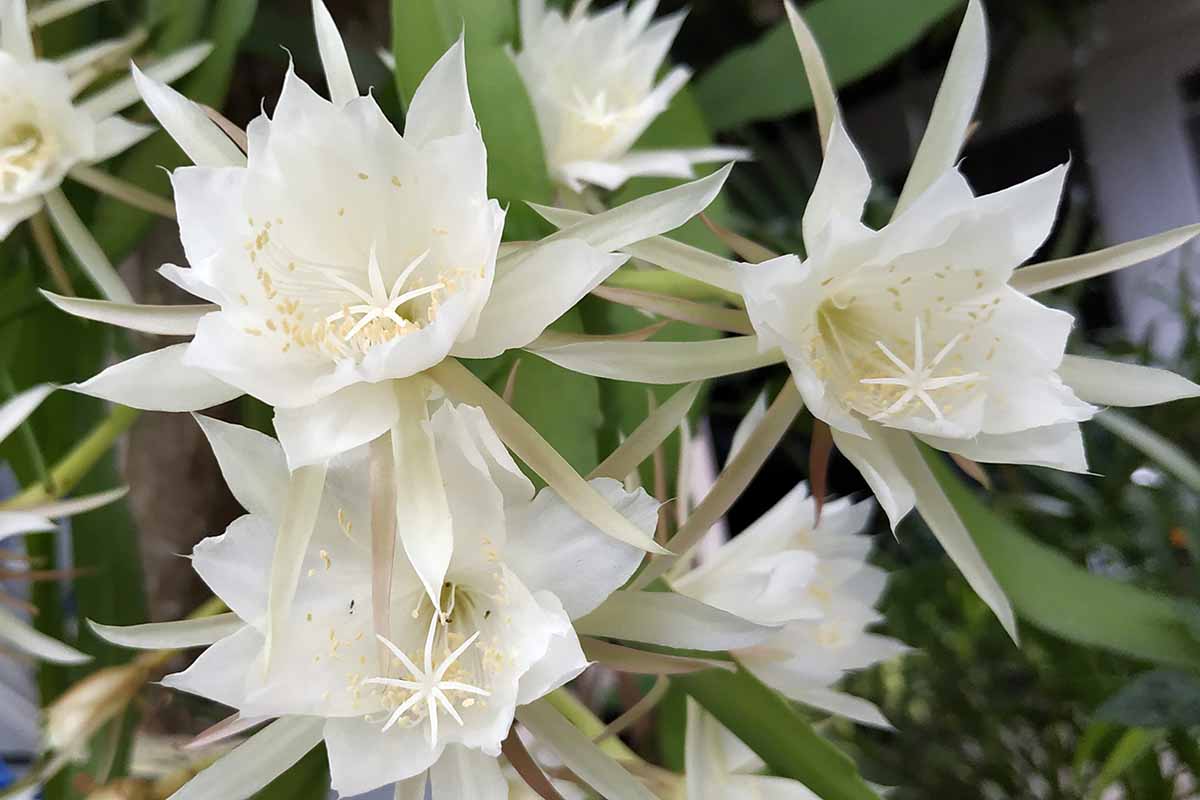
The blooms last for one to two days and appear in summer or early fall, on branching stems that can reach 18 feet long.
The stems start off upright but then take on a pendulous growth habit, making this plant suitable for a hanging basket.
22. Punchbowl
With its enthralling tricolored blooms, ‘Punchbowl’ is an epiphyllum hybrid that may make you feel giddy.

Broad overlapping mid-petals are purple, with white inner petals and red outer petals.
Each petal has a lighter colored midstripe. The stigma, style, and cascading stamens of this hybrid are white.
23. Unforgettable
‘Unforgettable’ is an epiphyllum hybrid with sumptuously hued, double, tricolored blooms.
Broad, overlapping petals are dark red to purple, with inner petals tinged with white.

The flowers of this orchid cactus are large, with a cup and saucer form. They have a white stigma and stamens, and pink styles.
Plants reach one to two feet tall and are suitable for hanging baskets.
Stamens and Petals and Stems, Oh My!
With their luxuriant, succulent foliage and their extravagant blooms, whichever epiphyllum you favor, you’re sure to delight in these species and hybrids.

Which epiphyllums are you growing? Do you have a favorite that wasn’t included in this list? Or are you trying to identify an orchid cactus and hoping for some help? Let us know in the comments section below!
If learning about cacti and succulents takes you to your happy place, you’re in luck! We have more reading for you right here:
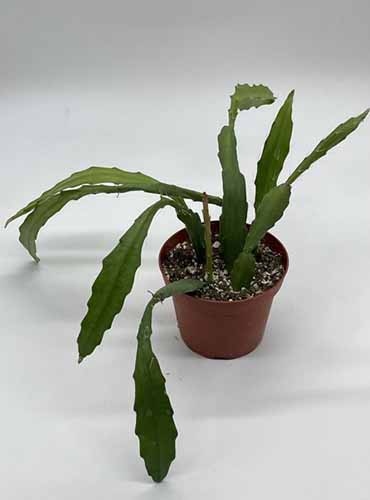
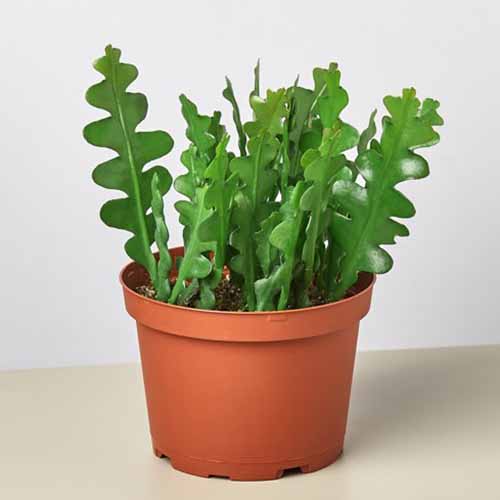




Wonderful article! I’ve recently branched out of Aroids and began collecting a few cloud forest/neotropicals 🙂 …. This article may help me to identify a handful of questionable beauties – thank you!
Hi Rita,
Thanks for your kind comments, I’m glad you enjoyed the article!
Awesome article! I wasn’t aware there were so many different types. I purchased a night blooming cereus from a vendor at a farmers market in Lafayette LA about 3 months ago.How can I identify which one I have purchased? Will I have to wait until it blooms?
Hi Maxine,
Glad you enjoyed the article! Feel free to go ahead and post some photos here of the plant without blooms and I may be able to help you hone in a bit on an ID. Unfortunately it can be nearly impossible to ID an epiphyllum (even when blooming) – many are sold without the vendor knowing what type they are even selling. But I may be able to help get you a bit closer, depending on what type you have.
This was a cutting that my former supervisor had planted and eventually gave me. At that time I was living in zone 7 and it survived, but was wimpy. I had no clue what plant it was and neither did anyone I asked. Two years ago we moved to zone 8 and she’s taken off! My daughter is the one who told me she thought it was a queen of the night, after using a plant ap. I’ve had this plant since 2017. See pic before we moved to zone 8 and pic of what it looks like now. Anyone… Read more »
Hi Nicole, Thanks for sharing your plant’s story and photos. She certainly has taken off and seems to like the new growing conditions! While an epiphyllum that is 6 years old or more is capable of blooming, it sounds like she was getting off to a slower start in your former location, so this could be part of the delay. However, I would recommend you check out our tips for encouraging blooming in our guide to growing and caring for epiphyllums to see what you might do try to get those big, beautiful flowers. It will be much easier to… Read more »
Hello I also appreciate all the detailed information. I just was gifted this cactus by a widower who said the plant was sad and hasn’t bloomed since his wife’s passing this year. He thought perhaps I could make it happy again and enjoy it. Its foliage is interesting but not “attractive “ So I am curious if the spots or dry patches or texture is normal in this species.It is an old plant she had for many years. As you can see from the photos it’s pretty root bound having taken shape of pot. So new pot will be first… Read more »
Hi Ann, Thanks for sharing the background story of your epiphyllum. I’m sure you’ll be able to make this plant happy again since you have already discovered one big thing it needs – to be repotted! And you’re correct – the spots and dry patches are not normal. This can happen when these plants get too much direct sun. Bright, indirect sun or filtered sunlight is best. I’m going to re-direct you to our complete guide to growing epiphyllums, where you’ll find tips on providing the right light exposure and repotting, as well as encouraging flowering. This article should help… Read more »